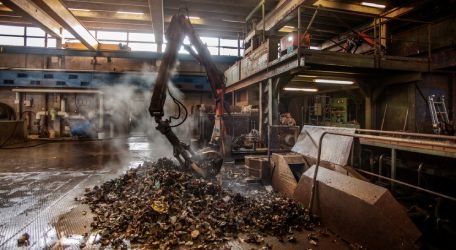Materials made of plastic and cardboard are typically the first to come to mind when considering recycling. Recycling these materials is essential, but it’s easy to forget about scrap metal. And yet, no matter how often it’s recycled, metal scrap retains its inherent qualities. This is a whole new level of product reuse.
Metals surround us constantly. They become sections of machines and products that we rely on often. One of the best things about metals is that they can be recycled endlessly without degrading. Aluminum, copper, gold, and silver all follow steel as the most recycled metals in the world.
We value transparency at BNE Copper Recycling and will keep you updated on our procedures. To better understand scrap metal recycling, read this article. Metal recycling and ferrous metal recycling will be covered. In addition, you will learn why it’s important to recycle metal and what good may come from old appliances.
RECYCLING of Scarp metal has several positive effects.
You can do your part for the environment while generating more cash by selling your scrap metal and recycling it. Benefits to the environment from recycling scrap metal include lessening the release of greenhouse gases and the prevention of littering.
Compared to producing new metals from raw ores and minerals, the emission of greenhouse gases during the scrap metal recycling process is substantially lower. According to the Institute of Scrap Metal Industries, recycling reduces annual greenhouse gas pollution by 300–500 million tonnes compared to manufacturing virgin metal. Furthermore, the recycled metal is equally durable as pure metal but requires far less energy.
For perspective, it takes 120 pounds of limestone, 2,500 pounds of iron ore, and 1,400 pounds of coal to produce one tonne of steel, so recycling even a small amount can have a significant impact. As a result, not only does it significantly lessen emissions of greenhouse gases, but it also helps conserve valuable minerals and other natural resources.
Reduced biological pollution is another benefit of recycling waste metal. Recycling-worthy ferrous and non-ferrous metals are commonly found in landfills. However, with scrap metal recycling, consumers are encouraged in the right direction when getting rid of their new metal.
Metal scraps must always be valuable, while other types of garbage might not. Scrap metal can be sold to any scrap metal recycling brisbane service for a fair fee.
Methods Used in Reusing Scrap Metal
Metals that have been discarded can be recycled through this operation. Products or structures nearing the end of their useful life are the sources of the material. However, scrap from factories is another viable option.
Metals may be recycled since they do not decay during the operation. New things can be made without worrying about leaving a large carbon imprint.
But what steps make up the recycling procedure for scrap metal? It isn’t very easy and takes a long time. Let’s say you’re in the construction or manufacturing industries and have scrap metal lying around. If that’s the case, you can drop it off at a trusted company specializing in recycling old materials. BNE Copper Recycling is a company that has been in business for a while and is dedicated to offering ecologically responsible scrap metal recycling services.
Do you have Google open and looking for “Scarp metal recycling near me“? Get the most money for your scrap metal at BNE Copper Recycling. Get in touch with us; we’ll pick up your scrap metal for free. We’ll take any metals as scrap here in Brisbane.
Your concerns about the fate of your scrap metal after selling it to BNE Copper Recycling are understandable. Take a look at how it operates below:
-
COLLECTING
Selling scrap metal can yield a seemingly infinite range of forms, styles, sizes, materials, etc. Scrapyards and individuals with metals to sell are the primary sources of metals. This is a simple first step, but it’s also very important. Motivated by this, more people are coming forward to recycle their scrap metal.
-
SORTING
Metals are separated into those that can be recycled and those that cannot once they have been gathered. Only high-quality metals are suitable for use in the recycling process. Hence a stringent quality check system is conducted. Lower-quality metals will result in a final product that doesn’t meet standards.
-
FILTERING AND SHREDDING
The metals are crushed to the smallest possible size to allow a smooth processing phase. This ensures a proper fit on the moving belt. They are compacted first, then shredded. To facilitate melting in the furnace, metal is sliced into smaller pieces. By having a larger surface area to volume ratio, melting the fragments requires less time and energy than melting the full pieces.
-
MELTING
The scrap metal is melted down using massive furnaces. A separate furnace is used to heat each metal to its ideal melting point. The melting process might last from minutes to hours, depending on the quantity and type of metal being melted. Despite the high energy requirements, this method is still more efficient than producing new metal from scratch.
-
SANITIZATION
After the metals have been melted, they must be refined to remove any impurities. Because impurities severely diminish a metal’s characteristics, this is done before the new metal is used. There are many ways to accomplish this, but electrolysis is common. Injecting a direct current causes an electrochemical reaction.
-
Cooling
After the metals have been cleaned, they are placed in a cooling chamber where chemicals are added to increase their density, allowing them to take on a more solid form.
Conclusion
The six-step procedure is infinitely sustainable. Don’t merely toss away any appliance or equipment nearing or has reached the end of its useful life. Get in touch with us at BNE Copper Recycling, and we’ll come and recycle it for you.
